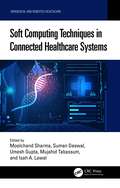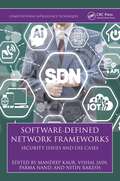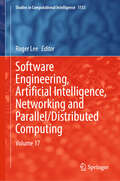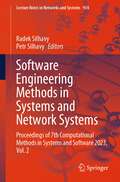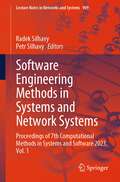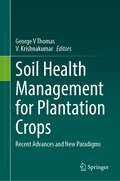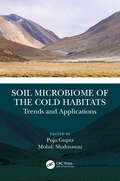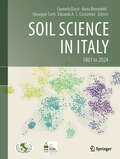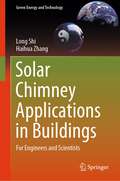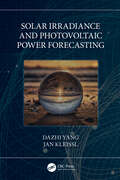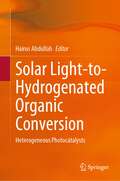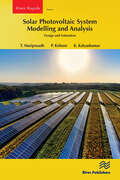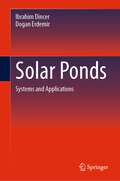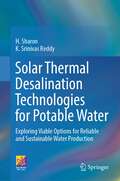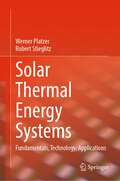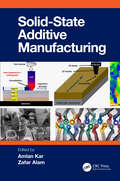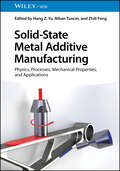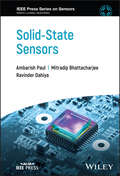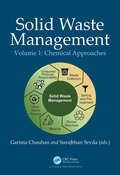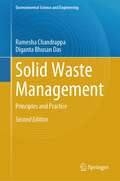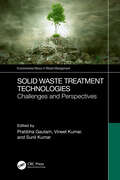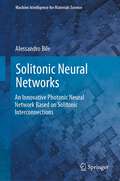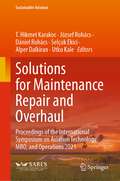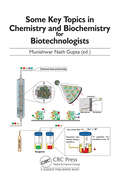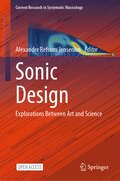- Table View
- List View
Soft Computing Techniques in Connected Healthcare Systems (Biomedical and Robotics Healthcare)
by Moolchand Sharma Suman Deswal Umesh Gupta Mujahid Tabassum Isah A. LawalThis book provides an examination of applications of soft computing techniques related to healthcare systems and can be used as a reference guide for assessing the roles of various techniques. Soft Computing Techniques in Connected Healthcare Systems presents soft computing techniques and applications used in healthcare systems, along with the latest advancements. The authors examine how connected healthcare is the essence of combining a practical operative procedure of interconnectedness of electronic health records, mHealth, clinical informatics, electronic data exchange, practice management solutions, and pharmacy management. The book focuses on different soft computing techniques, such as fuzzy logic, ANN, and GA, which will enhance services in connected health systems, such as remote diagnosis and monitoring, medication monitoring devices, identifying and treating the underlying causes of disorders and diseases, improved access to specialists, and lower healthcare costs. The chapters also examine descriptive, predictive, and social network techniques and discuss analytical tools and the important role they play in enhancing the services to connected healthcare systems. Finally, the authors address real-time challenges with real-world case studies to enhance the comprehension of topics. This book is intended for under graduate and graduate students, researchers, and practicing professionals in the field of connected healthcare. It provides an overview for beginners while also addressing professionals in the industry on the importance of soft computing approaches in connected healthcare systems.
Software-Defined Network Frameworks: Security Issues and Use Cases (ISSN)
by Mandeep Kaur Vishal Jain Parma Nand Nitin RakeshSoftware-Defined Networks (SDN) work by virtualization of the network and the Cognitive Software-Defined Network (CSDN) combines the efficiencies of SDN with cognitive learning algorithms and enhanced protocols to automatize SDN. Partial deployment of SDN along with traditional networking devices forms a Hybrid Software-Defined Network (HSDN). Software-Defined Network Frameworks: Security Issues and Use Cases consolidates the research relating to the security in SDN, CSDN, and Hybrid SDNs. The security enhancements derived from the use of various SDN frameworks and the security challenges thus introduced, are also discussed. Overall, this book explains the different architectures of SDNs and the security challenges needed for implementing them.Features: Illustrates different frameworks of SDN and their security issues in a single volume Discusses design and assessment of efficient SDN northbound/southbound interfaces Describes cognitive computing, affective computing, machine learning, and other novel tools Illustrates coupling of SDN and traditional networking – Hybrid SDN Explores services, technologies, algorithms, and methods for data analysis in CSDN The book is aimed at researchers and graduate students in software engineering, network security, computer networks, high performance computing, communications engineering, and intelligent systems.
Software Engineering, Artificial Intelligence, Networking and Parallel/Distributed Computing: Volume 17 (Studies in Computational Intelligence #1153)
by Roger LeeThis book reports state-of-the-art results in Software Engineering, Artificial Intelligence, Networking and Parallel/Distributed Computing. This edited book presents original papers on both theory and practice. It addresses foundations, state-of-the-art problems and solutions, and crucial challenges.
Software Engineering Methods in Systems and Network Systems: Proceedings of 7th Computational Methods in Systems and Software 2023, Vol. 2 (Lecture Notes in Networks and Systems #934)
by Radek Silhavy Petr SilhavyThis book presents cutting-edge research and methodologies in software engineering, specifically focusing on systems and network systems. It showcases novel development approaches and network system optimizations, highlighting the field's dynamic evolution. The book is designed for experts, scholars, and professionals, offering insights and tools crucial for advancing the software engineering landscape. Its diverse content makes it an invaluable resource for seasoned professionals and those new to the field, inspiring and enriching readers' understanding of software engineering's future directions.
Software Engineering Methods in Systems and Network Systems: Proceedings of 7th Computational Methods in Systems and Software 2023, Vol. 1 (Lecture Notes in Networks and Systems #909)
by Radek Silhavy Petr SilhavyThis book presents cutting-edge research and methodologies in software engineering, specifically focusing on systems and network systems. It showcases novel development approaches and network system optimizations, highlighting the field's dynamic evolution. The book is designed for experts, scholars, and professionals, offering insights and tools crucial for advancing the software engineering landscape. Its diverse content makes it an invaluable resource for seasoned professionals and those new to the field, inspiring and enriching readers' understanding of software engineering's future directions.
Soil Health Management for Plantation Crops: Recent Advances and New Paradigms
by V. Krishnakumar George V ThomasThis edited volume elucidates state-of-the-art information and provides new paradigms of soil health-based pathways for sustaining plantation crops and diversified systems. The book covers soil characteristics, soil fertility constraints, issues of soil contamination, the impact of climate change on plantation soils, indicators of soil health and soil health assessment, fertility management for healthy soils, soil amendments, soil biodiversity, and biological functions and micro-biome as well as meta-genomic approach.Plantation crops are perennials, cultivated in tropical and sub-tropical agroecosystems in a contiguous area, and comprise estate crops which include tea, coffee, and rubber and small holders’ plantation crops such as coconut, areca nut, oil palm, cashew, cocoa, and spices. These are high-value crops with considerable significance in livelihood security, commerce, and trade, and are grown in ecologically vulnerable regions such as coastal belts, hilly areas, andregions with high rainfall and high humidity, which makes maintenance of soil health a major challenge. Sustainable agricultural production depends on the health, quality, and functionality of the soil. The book includes technological options to achieve sustainable production encompassing soil health improvement through multi-strata, multi-species cropping systems, integrated farming systems, conservation agriculture practices, cover cropping and green manuring, crop residue recycling, bio-fertilizer and bio-stimulant technologies and organic farming systems.This book is an essential resource for researchers, plantation professionals, educators, and policymakers. It provides valuable insights and practical solutions for addressing emerging issues in soil health management and is a must-read for students of agriculture, forestry, ecology, microbiology, soil science, and environmental sciences.
Soil Microbiome of the Cold Habitats: Trends and Applications
by Puja Gupta and Mohd. ShahnawazThis book focuses on cold habitat microbes as a potential source of elite enzymes and secondary metabolites to meet the growing demands of the pharmaceutical, food and biotechnological industries. Microbes living in such extremely cold conditions are reported to produce various biomolecules with potential biotechnological applications. The book overviews recent research trends to discover such important biomolecules and also suggests future research directions to discover such elite novel biomolecules. Salient features: Covers studies on various biotic communities and abiotic components of the soil of terrestrial habitats with a focus on cold habitats Discusses various 'Omic' approaches: metagenomics and meta-transcriptomics Lists adaptation strategies adopted by cold-adapted microbes Highlights various biotechnological and industrially important biomolecules produced by cold-adapted microbes Explores the role of microbial biofilm in the degradation of microplastics in cold habitats
Soil Science in Italy: 1861 to 2024
by Carmelo Dazzi Anna Benedetti Giuseppe Corti Edoardo A.C. CostantiniHistory is generally defined as “the study of past events, particularly in human affairs” and is mostly understood when presented chronologically. That’s why someone also defined it as the ‘chronological record of the past’. Knowing the past is extremely important for any society and human being. Past gives us insights into our evolving behavior in many matters of life. The book is seen as a unique opportunity to preserve the memory of the Italian history of soil science. It represents a milestone and a cultural heritage. Moreover, the book is a sort of ideal bridge between the pioneers of soil science in Italy and the young generation of researchers, contributing to spreading awareness of the importance of soil as a fundamental resource.
Solar Chimney Applications in Buildings: For Engineers and Scientists (Green Energy and Technology)
by Long Shi Haihua ZhangThis book comprehensively describes the operating principles and theoretical foundations of solar chimneys. It covers current research results, including numerical analysis and mathematical models based on different assumptions. Complying with the application of renewable energy in sustainable buildings, solar chimney has received extensive attention as an indispensable part natural ventilation. This book is a guide to the application of solar chimneys from single zones to multi zones, and it provides a reference source of application for construction practitioners and engineering decision-makers. The design basis and the related basic principles of fluid mechanics and natural ventilation design strategies introduced in this book will also be beneficial to college students.
Solar Irradiance and Photovoltaic Power Forecasting (Energy Analytics)
by Dazhi Yang Jan KleisslForecasting plays an indispensable role in grid integration of solar energy, which is an important pathway toward the grand goal of achieving planetary carbon neutrality. This rather specialized field of solar forecasting constitutes both irradiance and photovoltaic power forecasting. Its dependence on atmospheric sciences and implications for power system operations and planning make the multi-disciplinary nature of solar forecasting immediately obvious. Advances in solar forecasting represent a quiet revolution, as the landscape of solar forecasting research and practice has dramatically advanced as compared to just a decade ago. Solar Irradiance and Photovoltaic Power Forecasting provides the reader with a holistic view of all major aspects of solar forecasting: the philosophy, statistical preliminaries, data and software, base forecasting methods, post-processing techniques, forecast verification tools, irradiance-to-power conversion sequences, and the hierarchical and firm forecasting framework. The book’s scope and subject matter are designed to help anyone entering the field or wishing to stay current in understanding solar forecasting theory and applications. The text provides concrete and honest advice, methodological details and algorithms, and broader perspectives for solar forecasting. Both authors are internationally recognized experts in the field, with notable accomplishments in both academia and industry. Each author has many years of experience serving as editors of top journals in solar energy meteorology. The authors, as forecasters, are concerned not merely with delivering the technical specifics through this book, but more so with the hopes of steering future solar forecasting research in a direction that can truly expand the boundary of forecasting science.
Solar Light-to-Hydrogenated Organic Conversion: Heterogeneous Photocatalysts
by Hairus AbdullahThis book highlights the promising photocatalytic methods for synthesizing organic chemicals by simultaneously degrading the toxicity of raw substances used for organic synthesis. It presents various semiconducting materials with high catalytic activities in hydrogen evolution reactions (HERs) and hydrogenation reactions, as well as the material characterizations for identifying semiconductor photocatalysts. The focus is on understanding the hydrogen dissociation and activation of substances in the process of hydrogenation and the fabrication of nanostructured catalysts with desired activity and selectivity. Recent works show photocatalytic hydrogenation reactions with in situ generated H+ on catalyst surfaces utilizing initial chemicals such as nitrophenol, nitrobenzene, azobenzene, and benzene for valorization. In addition, the photocatalytic valorization of waste glycerol is also discussed. Besides the hydrogenation reactions, the reduction of oxygen to form H2O2 can be done with a photocatalytic method in atmospheric conditions. Some related perspectives and outlooks are also discussed for possible future development.
Solar Photovoltaic System Modelling and Analysis: Design and Estimation (River Publishers Series in Power)
by T. Mariprasath P. Kishore K. KalyankumarThis book outlines the global opportunity to increase solar photovoltaic (PV) plant energy yields through modelling and analysis. Because it is endlessly available in Earth’s atmosphere, solar PV energy extraction is rising faster than all other renewable energy sources worldwide. Thus, technological improvements are needed to lower the cost of solar PV per watt every year. Since solar PV efficiency is low, modelling and analysis of boost converters, maximum power point tracing, solar PV cleaners, irradiation tracing systems, and panel tilt adjustments all help increase solar PV plant energy yield.Solar Photovoltaic System Modelling and Analysis covers topics such as: Relevance, types, and growth rate of renewable resources How solar PV systems generate electricity Panel varieties and their importance Solar PV designs and architectures Charge controllers, including the latest technologies Boost converter modelling and analysis in MATLAB The necessity of hybrid power plants (modelling and analysis) Designing a solar PV system including panel selection for a specific application, as well as converter and inverter estimation
Solar Ponds: Systems and Applications
by Ibrahim Dincer Dogan ErdemirThis book is about solar ponds for energy storage from various perspectives, including fundamentals, efficiencies, system designs, local applications and details about what have been done in the world in the field of solar ponds for generating energy and storage it for useful purposes.
Solar Thermal Desalination Technologies for Potable Water: Exploring Viable Options for Reliable and Sustainable Water Production
by H. Sharon K. Srinivas ReddyThis book covers the basics and advancements in various solar thermal desalination systems that are highly affordable and viable even for applications in low-income countries. Fresh water is an essential natural resource needed for the continuous existence of living organisms on earth. Civilizations have started and flourished along riverbanks which can be understood from historical literature. This precious resource has also been a cause for a lot of past and current wars and conflicts among different ethnic groups and nations around the globe. In the current scenario, access to clean drinking water is getting harder and more expensive for most of the population in middle- and low-income countries. This volume provides detailed knowledge on effectively utilizing solar energy for desalination to fulfill clean water supply demands. The content presents detailed thermodynamic modeling of various solar thermal desalination systems and highlights the role of the solar thermal distillation process in wastewater treatment and improved sanitation through a case study. The book also provides a detailed methodology for assessing the economics, environmental footprints, and sustainability of desalination systems. The book will be highly beneficial for researchers, professionals, and activists dealing with water, energy, and the environment.
Solar Thermal Energy Systems: Fundamentals, Technology, Applications
by Werner Platzer Robert StieglitzThis textbook is intended for master's level engineering students in the field of their studies. It begins with an analysis of the growing world population's energy demand (heat and electricity) and its connection to the undeniable climate change, necessitating the expansion of climate-friendly technologies. The book is divided into two sections. The first section (Chapters 2 to 7) presents the physical fundamentals of solar thermal energy usage, along with the necessary processes, methods, and models. The second section (Chapters 8-12) covers the synthesis of the developed fundamentals applied to various functional solar thermal systems. It not only provides the logic and methods for transferring the physical fundamentals into an operative technical system but also includes aspects of concept development, selection, economic evaluation, and performance. Additionally, measurement and control technology are presented, underpinned by real projects that have already been successfully implemented.
Solid State Additive Manufacturing
by Amlan Kar Zafar AlamThe text focuses on discussing the solid-state deformation behavior of materials in additive manufacturing processes. It highlights the process optimization and bonding of different layers during layer-by-layer deposition of different materials in Solid-State. It covers the design, process, and advancement of solid-state additive manufacturing methods. • Covers the fundamentals of materials processing, including the stress–strain–temperature correlation in solid-state processing and manufacturing. • Discusses solid-state additive manufacturing methods, and optimization strategies for the fabrication of additive manufacturing products. • Showcases the mechanisms associated with improvement in mechanical properties of Solid-State additive manufacturing products. • Provides a comprehensive discussion on microstructural stability and homogeneity in mechanical properties. • Presents hybrid solid-state process for fabrication of multilayer components and composite materials. • Provides a detailed review of laser-based post-processing techniques The text focuses on the Solid-State additive manufacturing techniques for the fabrication of industrially relevant products. It gives in-depth information on the fundamental aspects, hybridization of the processes, fabrication of different materials, improvement in product performance, and Internet of Things enabled manufacturing. The text covers crucial topics, including hybrid Solid- State additive manufacturing, cold spray additive manufacturing, online defect detection of products, and post-processing of additively manufactured components. These subjects are significant in advancing additive manufacturing technology and ensuring the quality and efficiency of the produced components. It will serve as an ideal reference text for senior undergraduate and graduate students, and researchers in fields such as mechanical engineering, aerospace engineering, manufacturing engineering, and production engineering. .
Solid-State Metal Additive Manufacturing: Physics, Processes, Mechanical Properties, and Applications
by Hang Z. Yu Nihan Tuncer Zhili FengSolid-State Metal Additive Manufacturing Timely summary of state-of-the-art solid-state metal 3D printing technologies, focusing on fundamental processing science and industrial applications Solid-State Metal Additive Manufacturing: Physics, Processes, Mechanical Properties, and Applications provides detailed and in-depth discussion on different solid-state metal additive manufacturing processes and applications, presenting associated methods, mechanisms and models, and unique benefits, as well as a detailed comparison to traditional fusion-based metal additive manufacturing. The text begins with a high-level overview of solid-state metal additive manufacturing with an emphasis on its position within the metal additive manufacturing spectrum and its potential for meeting specific demands in the aerospace, automotive, and defense industries. Next, each of the four categories of solid-state additive technologies—cold spray additive manufacturing, additive friction stir deposition, ultrasonic additive manufacturing, and sintering-based processes—is discussed in depth, reviewing advances in processing science, metallurgical science, and innovative applications. Finally, the future directions of these solid-state processes, especially the material innovation and artificial intelligence aspects, are discussed. Sample topics covered in Solid-State Metal Additive Manufacturing include: Physical processes and bonding mechanisms in impact-induced bonding and microstructures and microstructural evolution in cold sprayed materialsProcess fundamentals, dynamic microstructure evolution, and potential industrial applications of additive friction stir depositionMicrostructural and mechanical characterization and industrial applications of ultrasonic additive manufacturingPrinciples of solid-state sintering, binder jetting-based metal printing, and sintering-based metal additive manufacturing methods for magnetic materialsCritical issues inherent to melting and solidification, such as porosity, high residual stress, cast microstructure, anisotropic mechanical properties, and hot cracking Solid-State Metal Additive Manufacturing is an essential reference on the subject for academic researchers in materials science, mechanical, and biomedicine, as well as professional engineers in various manufacturing industries, especially those involved in building new additive technologies.
Solid-State Sensors (IEEE Press Series on Sensors)
by Ambarish Paul Mitradip Bhattacharjee Ravinder DahiyaSolid-State Sensors A thorough and up-to-date introduction to solid-state sensors, materials, fabrication processes, and applications Solid-State Sensors provides a comprehensive introduction to the field, covering fundamental principles, underlying theories, sensor materials, fabrication technologies, current and possible future applications, and more. Presented in a clear and accessible format, this reader-friendly textbook describes the fundamentals and classification of all major types of solid-state sensors, including piezoresistive, capacitive, thermometric, optical bio-chemical, magnetic, and acoustic-based sensors. Throughout the text, the authors offer insight into how different solid-state methods complement each other as well as their respective advantages and disadvantages in relation to specific devices and a variety of state-of-the-art applications. Detailed yet concise chapters include numerous visual illustrations and comparative tables of different subtypes of sensors for a given application. With in-depth discussion of recent developments, current research, and key challenges in the field of solid-state sensors, this volume: Describes solid-state sensing parameters and their importance in sensor characterization Explores possible future applications and breakthroughs in associated fields of research Covers the fundamental principles and relevant equations of sensing phenomena Discusses promising smart materials that have the potential for sensing applications Includes an overview of the history, classification, and terminology of sensors With well-balanced coverage of the fundamentals of sensor design, current and emerging applications, and the most recent research developments in the field, Solid-State Sensors is an excellent textbook for advanced students and professionals in disciplines such as Electrical and Electronics Engineering, Physics, Chemistry, and Biomedical Engineering.
Solid Waste Management: Chemical Approaches, Volume 1
by Garima Chauhan Surajbhan Sevda‘Waste’ is generally identified as goods or material that are perceived to be mostly valueless. However, objects that are perceived to be waste based on consumers’ object valuation can be redefined to create value. This requires a multitude of efforts using different strategies in waste prevention and management. This book is an edited collection of various chemical approaches used for valorization of solid wastes, particularly, waste electrical and electronic equipment, plastic waste, and agro-residue waste, that provide research insights into the concept "waste-to-energy". Covering a variety of interdisciplinary topics on waste treatment and resource recovery makes the book one for all that serves as an excellent reading material for engineers, science scholars, entrepreneurs, and organizations who are working in the field of waste management.
Solid Waste Management: Principles and Practice (Environmental Science and Engineering)
by Ramesha Chandrappa Diganta Bhusan DasThis book discusses solid waste management issues from global to local level. It offers an overview of the methods and paradigms of this burgeoning field, ranging from generation, characteristics, quantity, and practical challenges. The book discusses the major issues with respect to environmental health and economy, which are related to solid waste management. Furthermore, it contains updated information on topics such as toxicology, climate change, population pressure, urbanization, energy production, building and community design, and disaster preparedness in the context of solid waste management.
Solid Waste Treatment Technologies: Challenges and Perspectives (Environmental Nexus in Waste Management)
by Pratibha Gautam Vineet Kumar Sunil KumarSustainable waste management is a major step towards the attainment of Sustainable Development Goals. This book covers all technical, managerial, and legislative aspects of waste management at a global scale, providing a detailed description about different types of wastes, their characteristics, legal perspectives, and sustainable practices for their management. It explains developments in waste treatment technologies (classified based on waste type) and understanding the fundamentals of circular economy in waste management, supported by various case studies. Features: Discusses fundamentals of solid waste management for sustainable waste management practices Describes technological aspects of waste management covering various physicochemical, biochemical, and thermochemical processes Summarizes regulatory framework for waste management at the global level Highlights the scope for circular economy in managing solid wastes Includes dedicated chapters on case studies imperative for capacity building in waste management This book is aimed at researchers, graduate students, and professionals in environmental engineering, and waste management.
Solitonic Neural Networks: An Innovative Photonic Neural Network Based on Solitonic Interconnections (Machine Intelligence for Materials Science)
by Alessandro BileThis book delves into optics and photonic materials, describing the development of an intelligent all-optical system capable of replicating the functional building blocks of the biological brain. Starting with an analysis of biological neuronal dynamics and traversing the state of the art of neuromorphic systems developed to date, the book arrives at a description of neural networks realized through spatial soliton technology.After a brief introduction to the biology of neural networks (Chapter 1), the book delves into the description of the neuromorphic problem emphasizing the peculiarities of optical hardware developed to date. (Chapter 2). Chapter 3 is dedicated to the description of psychomemories , which represent the modeling of human learning according to the theories of modern neuro-psychology. This chapter provides the prerequisites for understanding how solitonic neural networks (SNNs) are able to learn and how they approach biological models. Chapter 4 focuses on the experimentation of solitonic optic neurons in thin layers of lithium niobate. Optical techniques for supervised and unsupervised learning are discussed. The entire chapter is accompanied by theoretical, simulative and experimental results. This chapter explains how an X-junction neuron is able to establish synapses, modify them, or erase them. The erasure of solitonic structures represents an important innovation in the field of nonlinear optics. Finally, Chapter 5 reports on the implementation of a network of neurons capable of processing information and storing it exactly as a human episodic memory does. The chapter ends with a number of insights into the lines of research that are currently being pursued on the basis of the results obtained.The book is meant for graduate students and researchers in the fields of optics, photonic applications, and biology. However, the main beneficiaries of this book are senior researchers in the field of nonlinear optics and artificial intelligence. To fully understand the results, it is important to have a basic knowledge of optical physics and neuron biology.
Solutions for Maintenance Repair and Overhaul: Proceedings of the International Symposium on Aviation Technology, MRO, and Operations 2021 (Sustainable Aviation)
by T. Hikmet Karakoc József Rohács Dániel Rohács Selçuk Ekici Alper Dalkiran Utku KaleThe International Symposium on Aircraft Technology, MRO, and Operations (ISATECH) is a multi-disciplinary symposium that presents research on current issues in the field of aerospace. The conference provides a platform offering insights on the latest trends in aircraft technology, maintenance, repair, overhaul, and operations that offer innovative solutions to the challenges facing the aviation industry. ISATECH allows researchers, scientists, engineers, practitioners, policymakers, and students to exchange information, present new technologies and developments, and discuss future direction, strategies and priorities.
Some Key Topics in Chemistry and Biochemistry for Biotechnologists
by Munishwar Nath GuptaThe book is aimed at providing an exposure to some important topics which are generally not covered adequately in formal courses in biotechnology. It informs the readers about: How micro-fluidics are proving useful in enzyme kinetics. Chemi-proteomics; combinatorial chemistry and high-throughput screening in the context of drug discovery. How enzymes can be used with gaseous substrates? How to source more robust enzymes from marine resources for diverse applications? Why some nano-materials can be chiral? Synthesis of diverse quantum dots as powerful fluorescent probes in biology. How basics of surface chemistry and immunology are vital in dealing with endemics/pandemics like Covid-19.
Sonic Design: Explorations Between Art and Science (Current Research in Systematic Musicology #12)
by Alexander Refsum JenseniusThis open access book offers a historical context and an overview of the field's current artistic and scientific research. Sonic design includes the construction and performance of acoustic instruments but also recording, editing, mixing, and synthesizing sounds using analog and digital electronic devices. This book explores sonic design from the perspectives of music theory, music perception, embodied cognition, phenomenology, soundscape studies, acoustics, new interfaces for musical expression, sound and music computing, and music information retrieval. The chapters are selected contributions from an international seminar organized to celebrate the achievements of Professor Rolf Inge Godøy at the University of Oslo. As a composer, researcher, teacher, and supervisor, Professor Godøy has been central in developing a holistic approach to sonic design, from theory to practice. This book offers a comprehensive overview of the field's current state, making it essential reading for students, practitioners, and researchers across a wide range of disciplines.
